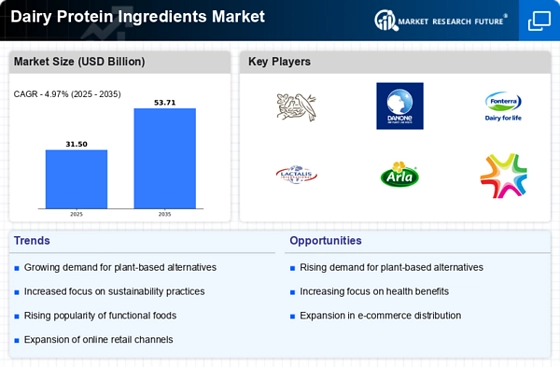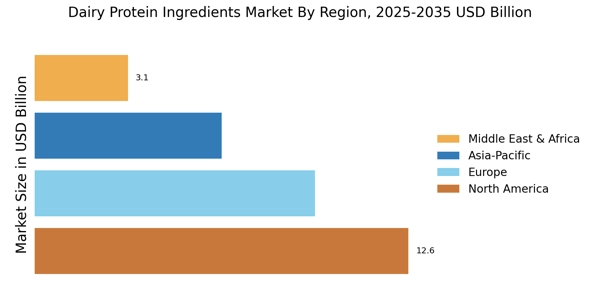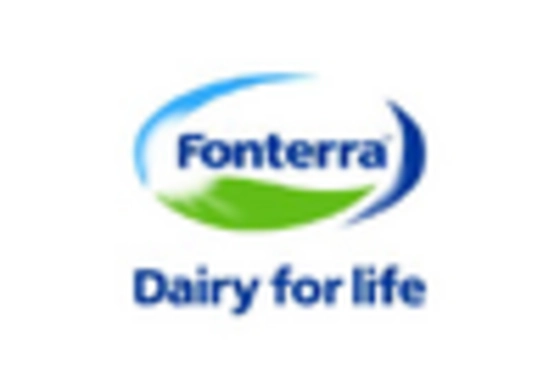Rising Demand for Protein-Rich Diets
The Dairy Protein Ingredients Market is experiencing a notable surge in demand for protein-rich diets, driven by increasing health consciousness among consumers. As individuals become more aware of the benefits of protein for muscle maintenance and overall health, the consumption of dairy protein ingredients is likely to rise. According to recent data, the protein intake recommendations have led to a projected growth rate of approximately 7% annually in the dairy protein segment. This trend is particularly evident among fitness enthusiasts and health-conscious individuals who seek high-quality protein sources. The Dairy Protein Ingredients Market is thus positioned to benefit from this shift in dietary preferences, as consumers increasingly opt for products that align with their nutritional goals.
Expansion of Plant-Based Alternatives
The Dairy Protein Ingredients Market is witnessing a significant impact from the expansion of plant-based alternatives. As consumers explore diverse dietary options, the demand for dairy protein ingredients is evolving. While plant-based products are gaining traction, they often lack the complete amino acid profile found in dairy proteins. This presents an opportunity for the Dairy Protein Ingredients Market to emphasize the unique benefits of dairy proteins, such as their high biological value and digestibility. Market data suggests that the dairy protein segment could see a resurgence as consumers seek to balance their diets with both plant-based and dairy sources. The interplay between these two segments may redefine consumer preferences and drive innovation within the Dairy Protein Ingredients Market.
Growing Interest in Clean Label Products
The Dairy Protein Ingredients Market is witnessing a growing interest in clean label products, as consumers increasingly demand transparency in food sourcing and ingredient lists. This trend is prompting manufacturers to reformulate their products to include fewer, more recognizable ingredients. Dairy protein ingredients, known for their natural origins, align well with this clean label movement. Market data suggests that products featuring clean labels are experiencing higher sales growth compared to conventional options. As consumers prioritize health and sustainability, the Dairy Protein Ingredients Market is likely to see a shift towards more natural and minimally processed dairy protein offerings, catering to the evolving preferences of health-conscious consumers.
Technological Advancements in Processing
Technological advancements in processing methods are playing a crucial role in shaping the Dairy Protein Ingredients Market. Innovations such as membrane filtration and enzymatic hydrolysis are enhancing the extraction and purification of dairy proteins, resulting in higher quality ingredients. These advancements not only improve the nutritional profile of dairy proteins but also cater to the growing demand for specialized products, such as hydrolyzed whey protein for sports nutrition. The Dairy Protein Ingredients Market is likely to benefit from these developments, as manufacturers can offer a wider range of products that meet specific consumer needs. Furthermore, the efficiency of these technologies may lead to cost reductions, making dairy protein ingredients more accessible to a broader audience.
Increased Application in Functional Foods
The Dairy Protein Ingredients Market is experiencing increased application in functional foods, which are designed to provide health benefits beyond basic nutrition. As consumers seek products that support their health and wellness goals, dairy proteins are being incorporated into a variety of functional food applications, including protein bars, beverages, and fortified snacks. Market analysis indicates that the functional food sector is projected to grow significantly, with dairy proteins playing a pivotal role in this expansion. The Dairy Protein Ingredients Market is thus well-positioned to capitalize on this trend, as manufacturers innovate to create products that not only satisfy hunger but also deliver added health benefits, such as improved gut health and enhanced muscle recovery.


















Leave a Comment